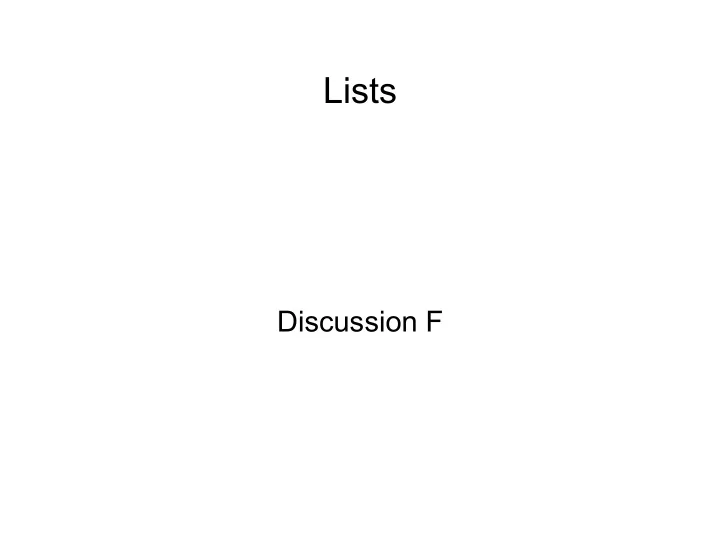

Lists Discussion F
Generics Tutorial (Ref: Gilad Baracha) ● Auto Boxing ● Erasure ● Sub Classes ● Unchecked Type cast ● Bounded Wildcards
Iterator List<Integer> lint = new ArrayList<Integer>(); //1 lint.add(new Integer(100)); //2 Iterator<Integer> intIter = lint.iterator(); //3 Integer i1 = intIter.next(); //4 lint.add(101); //5 int i2 = intIter.next(); //6 ConcurrentModificationException
Erasure public class X { public X();} //7 public class Y extends X { public Y();} //8 List<X> lx = new ArrayList<X>(); //9 List<Y> ly = new ArrayList<Y>(); //10 System.out.println(lx.getClass()==ly.getClass());//12 true
Erasure (2) public class X { public X();} //7 public class Y extends X { public Y();} //8 List<X> lx = new ArrayList<X>(); //9 List<Y> ly = new ArrayList<Y>(); //10 if (lx instanceof ArrayList<X>) {}//unchecked warning List<X> otherlx = (List<X>) lx;
Subtype public class X { public X();} //7 public class Y extends X { public Y();} //8 List<X> lx = new ArrayList<X>(); //9 List<Y> ly = new ArrayList<Y>(); //10 lx = ly; //11 Compiler Error
Subtype (2) void printCollection(Collection c) { //13 Iterator i = c.iterator(); while(i.hasNext()) { System.out.println(i.next()); } } void printCollection(Collection<Object> c) { //14 for (Object o: c) { System.out.println(o); } } printCollection(lint); //??
Bounded Wildcards ● Used to express polymorphism ● Wildcard, means some type – <?> ● lower bound, some super type of T – <? super T> ● upper bound, some sub class of B – <? extends B>
Wildcards void printCollection(Collection<?> c){ for (Object o: c) { System.out.println(o); } } Collection<?> c = new ArrayList<Integer>(); c.add(new Object()); // Error void printCollection(Collection<? extends Shape> c){ for (Shape s: c) { System.out.println(s.area()); } }
Generic Functions <T> void arrayToCollection(T[] a, Collection<T> c) { for (T t: a) { c.add(t); } } Integer [] a = new Integer[10];... Collection<Integer> c = new ArrayList<Integer>(); arrayToCollection(a, c); •No need to pass actual type, compiler infers it •They can have bounds too •Used when arguments/return type are correlated
Inner Classes ● Block Scoped – definition similar to definition of a field or a method ● Static – do not have the block scope
Snippets // 1 public class X { //1 private int fx; public class I { int fi; public I() { fi = fx; } } } X.I ci = new X.I(); // to run main method in X.I java X$I
// 2 public class X { //2 private int fx; private I i = new I(); private int fx2 = i.fi; public class I { private int fi; public I() { fi = fx; } } }
// 3 public class X { //3 int fx; public static class I { int fi; public I() { fi = fx; } } }
DisInherit Methods ● Not really, has to satisfy Is-a ● Illegal to narrow visibility ● Can reimplement and throw exception
DisInherit public class X { public void function() {} } public class Y extends X { private void function() {} // compiler error } public class Z extends X { private void function() { throw new NoSuchMethodException(); } }
Lisp List car cdr car cdr
Lisp List Interface public interface LispList<E> { public int length(); public E first (); public LispList<E> rest (); }
Lisp List public Cons<E> implements LispList<E> { E car; LispList<E> cdr; public Cons(E e) {car = e;} public Cons(LispList<E> onelist, LispList<E> otherlist) {} public int length() {} public E first () {return car;} public LispList<E> rest () {return cdr;} }
Lisp List ● Empty list ● How to construct from two lists? ● How to find length?
List of Arrays 3 2 1 100 100 100
List Of Arrays ● Each node has same capacity – can compute how many nodes from start the required index will be ● nodes have different capacity – can balance the list length
Using List<E> public class ListOfArrays<E> { int totalCount; int totalCapacity; int nodeCapacity; List<E []> list; private void checkIndex(int idx) {} public E get(int idx){} public void set(int idx, E e) {} }
List of Arrays public class ListOfArrays<E> { int totalCount; int totalCapacity; List<DataNode<E>> list; private class DataNode<E> { int count; int capacity; E [] array; } private void checkIndex(int idx) {} public E get(int idx){} public void set(int idx, E e) {} }
Recommend
More recommend